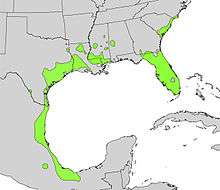Erythrina herbacea
| Erythrina herbacea | |
|---|---|
 | |
| Flowers | |
| Scientific classification | |
| Kingdom: | Plantae |
| (unranked): | Angiosperms |
| (unranked): | Eudicots |
| (unranked): | Rosids |
| Order: | Fabales |
| Family: | Fabaceae |
| Genus: | Erythrina |
| Species: | E. herbacea |
| Binomial name | |
| Erythrina herbacea L. | |
 | |
| Natural range | |
| Synonyms | |
Erythrina herbacea, commonly known as the coral bean, Cherokee bean, Mamou plant in South Louisiana, red cardinal or cardinal spear, is a flowering shrub or small tree found throughout the southeastern United States and northeastern Mexico;[1] it has also been reported from parts of Central America and, as an introduced species, from Pakistan. Various other systematic names have been used for this plant in the past, including Erythrina arborea, Erythrina hederifolia, Erythrina humilis, Erythrina rubicunda, Corallodendron herbaceum and Xyphanthus hederifolius.
Description
Coral bean grows as a low shrub or small tree, reaching around 5 m (16 ft) in height in areas that do not kill it back by freezing;[2] elsewhere it may only reach 1.2 m (3.9 ft). Stems are covered in curved spines.[3] The leaves are yellowish-green, 15–20 cm (5.9–7.9 in) long and 6 cm (2.4 in) wide. The leaves are divided into three 2.5–8 cm (0.98–3.15 in) arrowhead-shaped leaflets.[2] The bark is smooth and light gray.[4] The tubular flowers are bright red and grow in long spikes,[5] each flower being 4–6.5 cm (1.6–2.6 in) long;[2] the tree blooms from April to July.[3] They are followed by 5–10 cm (2.0–3.9 in) pods containing bright red seeds, from which the tree gets its name.[2] The plant forms a woody caudex.[6] Toxic alkaloids, including erysopine, erysothiopine, erysothiovine, erysovine, erythrinine, erythroresin, coralin, erythric acid, and hypaphorine,[7] are found throughout the plant. These cause paralysis upon ingestion, much like curare.[8]
Habitat and range
Coral bean grows best in sandy soils and has moderate salt tolerance. It can be found in open woods, forest clearings, hammocks, and disturbed areas.[9] In the United States, it can be found from southeastern North Carolina south to Florida and west to southeastern Oklahoma and eastern Texas.[6] E. herbacea inhabits Tamaulipas in Mexico.[1]
Erythrina herbacea have also been noted to be found in some areas of the Dragoon Mountains in Southern Arizona, located around areas of the Cochise Stronghold and other older Indian remnants. It is noted to have most-likely been introduced through trade from the Mogollon culture that existed in the area from 150AD to 1400AD and possibly even the later Apache Indians that occupied the area in the 19th century. Confirmation of Erythrina herbacea, Dec. 27 2013, of Erythrina herbacea in the Council Rocks area of the Dragoon Mountains, a prominent area filled with signs of Mogollon culture. Further research of the surrounding area is needed for range confirmation.
Uses
Erythrina herbacea can be readily grown in gardens within its natural range. Although its use in gardens is not particularly common, it is popular among those who do grow it as a source of early season color, for its hardiness (USDA Zones 7-10), and because it attracts hummingbirds.[10]
Native American people had many medicinal uses for this plant, varying between nations and localities. Creek women used an infusion of the root for bowel pain; the Choctaw used a decoction of the leaves as a general tonic; the Seminole used an extract of the roots for digestive problems, and extracts of the seeds, or of the inner bark, as an external rub for rheumatic disorders.[11]
In Mexico, the seeds are used as a rat poison, while a fish poison is made from the bark and leaves.[8]
In some Central American countries the flowers are used in traditional cuisine. Mostly added to bean soup or meat patties, it is known for its mild narcotic properties.
References
| Wikimedia Commons has media related to Erythrina herbacea. |
| Wikispecies has information related to: Erythrina herbacea |
- 1 2 3 "Taxon: Erythrina herbacea L.". Germplasm Resources Information Network. United States Department of Agriculture. 1998-09-07. Retrieved 2009-10-24.
- 1 2 3 4 Nelson, Gil (1994). The Trees of Florida: a Reference and Field Guide. Pineapple Press Inc. p. 213. ISBN 978-1-56164-055-3.
- 1 2 Duncan, Wilbur H.; Marion B. Duncan (2005). Wildflowers of the Eastern United States. University of Georgia Press. p. 39. ISBN 978-0-8203-2747-1.
- ↑ "Coral Bean Erythrina herbacea". FieldGuides. eNature. Retrieved 2009-10-24.
- ↑ "Erythrina herbacea L.". Native Plant Information Network. Lady Bird Johnson Wildflower Center. Retrieved 2009-10-24.
- 1 2 Neyland, Roy (2009). Wildflowers of the Coastal Plain. LSU Press. p. 131. ISBN 978-0-8071-3407-8.
- ↑ Austin, Daniel F. (2004). Florida Ethnobotany. CRC Press. p. 291. ISBN 978-0-8493-2332-4.
- 1 2 Tull, Delena (1999). Edible and Useful Plants of Texas and the Southwest: A Practical Guide. University of Texas Press. p. 254. ISBN 978-0-292-78164-1.
- ↑ "Coralbean (Erythrina herbacea)". Florida Forest Plants. Florida 4-H Forest Ecology. Retrieved 2009-10-24.
- ↑ Bird Gardens: Welcoming Wild Birds to Your Yard. Brooklyn Botanic Garden. 1998. p. 56. ISBN 978-1-889538-08-2.
- ↑ Moerman, Daniel E. (2009). Native American Medicinal Plants: An Ethnobotanical Dictionary. Timber Press. p. 227. ISBN 978-0-88192-453-4.
- Florida atlas of Vascular Plants: Erythrina herbaracea"
- Plants data base entry: Erythrina herbacea
- Alden, Peter; Rick Cech; Richard Keen; Amy Leventer; Gil Nelson; Wendy B. Zomlefer (1998). National Audubon Society Field Guide to Florida. New York: Alfred A. Knopf.
External links
- "Erythrinaz+herbacea" (PDF). Digital Representations of Tree Species Range Maps from "Atlas of United States Trees" by Elbert L. Little, Jr. (and other publications). United States Geological Survey.
